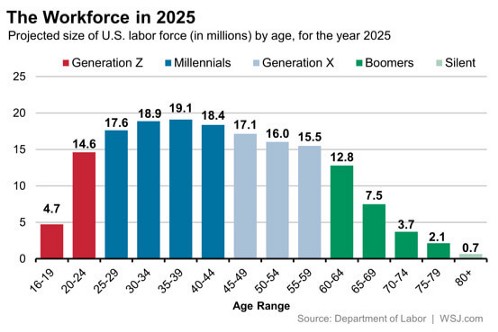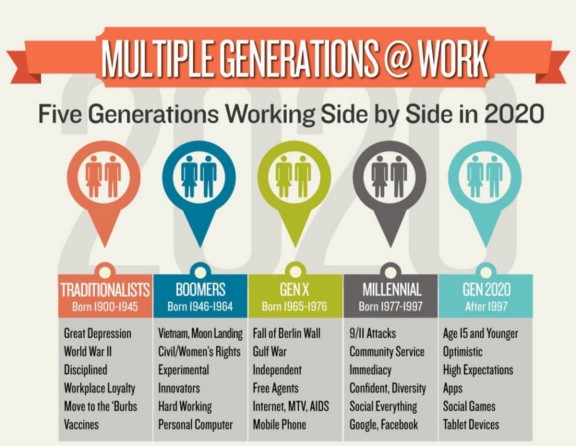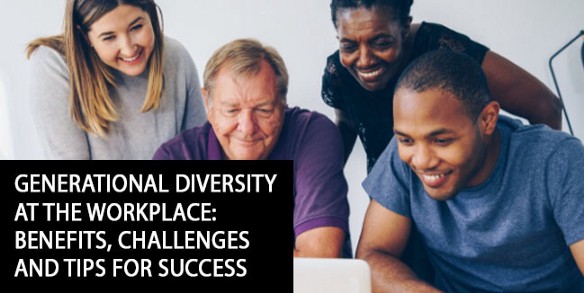According to the Department of Labor, by the year 2025, Baby Boomers, Generation X, Millennials, and Generation Z will comprise 99,3% of the US workforce. As the average age of the population increases and the rate of unemployment drops, companies will need to develop effective methods for managing generational diversity.
For the first time in history, there will be more than four different generations working together and sharing their unique ideas and values. There are various benefits to multigenerational diversity at the workplace, but employers will also be faced with a number of challenges.
In this article, we’ll look at the four major generations in the workforce, analyze the biggest benefits and challenges, and suggest a few strategies for managing a diverse workforce.
Four generations of workers
Let’s take a closer look at the four major generations comprising the workforce of today:
- Baby Boomers. Baby boomers are the people born between 1946 and 1964. They’re known to be very hardworking and motivated by position and perks. Baby boomers are also achievement-oriented, dedicated and career-focused. They equate work and position with self-worth and are quite competitive in the workplace.
- Generation X. Generation X are the people born between 1965 and 1980. Although they might not be as tech-savvy as the younger generations, they’re actually quite comfortable using technology. One study even showed that 54% of Gen X and 56% of Millennials are digitally savvy. They’re believed to have introduced the work/life balance movement to the workplace. What’s more, Gen X workers are highly independent and self-sufficient, value their freedom, and avoid micro-management in the workplace.
- Generation Y. Generation Y includes people who were born between 1981 and 1996. They already make up 50% of the population, and this number is expected to grow to 75% by 2025. Just like the employees from the previous Gen X, they desire work\life balance and flexibility at the workplace like working from home. Their goal is to work smarter rather than harder. Also called Millennials, these people thrive on innovations and are into the startup mentality.
- Generation Z. This is the generation born between 1996 and 2010. They’re slowly breaking into the labor force and are predicted to make up one-fifth of it by 2021. Their expectations and aspirations are different from the Millennials’ and are considered the most tech-savvy generation of the four. They’re more cautious and prefer career stability.


Benefits of generational diversity
- Knowledge-sharing. Knowledge-sharing is one of the main benefits of generational diversity at the workplace. Each generation has knowledge sets to offer to the workplace. This can be valuable both to their colleagues and the company as a whole. Younger generations can receive practical advice from older age groups as they have more work expertise and experience. Older age groups have plenty of things to learn from the younger generations. Their younger colleagues have more knowledge around new practices relating to IT and social media.
- Different perspectives. Age diversity can bring different perspectives into the workplace. For example, older generations are associated with more measured reactions, using their experience for help. Younger generations are associated with quick reactions and thought processes. Both approaches are very important to the workplace.
- Improved customer experience. By introducing generational diversity at the workplace, you can gain better insight into the different target audiences you’re trying to reach.
Challenges of generational diversity at the workplace
Generational diversity at the workplace also comes with a number of challenges. Here are the top 3 challenges I’d like to mention:
- Lack of shared interests. The lack of shared interests reflects back to each generation’s work priorities. For example, Baby Boomers are hardworking and motivated by position. Generation Y, on the other hand, believes in working smarter and not harder. For one generation, their job is their livelihood. For others, it’s a stepping stone to other things.
- Difference in communication. Each generation prefers to communicate in different ways. Baby Boomers, for example, prefer to communicate face-to-face or over the phone. Millennials like communicating digitally through email and instant messaging. The difference in communication can lead to miscommunication between employees, or no communication at all.
- Difference in working styles. Older and younger employees go separate ways when it comes to their working styles. While older generations don’t mind working long hours in the office, younger generations prefer flexibility and the option to work remotely.


Image Source: Inclusive Dubuque
What are the best practices for managing generational diversity?
There are several ways in which you can promote and support generational diversity at the workplace without making it an issue. Let’s take a look:
Recruit via different channels
If you’re aiming to put together a multigenerational team, the recruitment process will be especially important. If you want to recruit Baby Boomers, for example, consider reaching them via referrals or your professional network. Recruiting people from Gen Z will require using different online recruitment channels. One option is online campaigns on social media.
Write your message to appeal to diverse candidates
Knowing how to attract each generation can lead to a more effective and successful recruitment process. For example, Baby Boomers believe in “face time” at the office. They value exciting, challenging projects and strive to make a difference. Make sure you craft your message wisely when reaching out to this age group and try to avoid hiring bias.
On the other hand, Millennials care a great deal about personal development opportunities, work\life balance, and working with a sense of purpose. Make sure you mention these things when writing your job description.
Offer access to development opportunities
Employees working in larger organizations report that all age groups are given the same access to training and development opportunities. However, people working in a smaller organization report that younger groups get more career development opportunities. Older colleagues said that they need to push harder to have the same access to career advancement.
To successfully manage a diverse age group, you need to encourage a culture that appreciates the continuing need for training and advancement amongst all age groups.
Encourage knowledge-sharing
Employees were shown four ways in which an organization can help to support age diversity, including:
- Line manager training
- Getting everyone to understand the importance of age diversity
- Awareness training
- Mentoring and shared learning
They chose mentoring and shared learning.
One way of supporting shared learning is through age-diverse teams. By creating diverse teams, you can take advantage of the unique strengths of each generation. What’s more, you’ll also encourage your employees to communicate and collaborate with each other. For example, a Baby Boomer can have more knowledge of the specific industry you work in, while Millennials can offer their skills in IT.
Adopt different communication styles
Communication at the workplace is an important aspect of a high-performing organization. In order to make sure each employee is performing well and the entire team is in sync, communication is the key.
However, as I’ve previously mentioned, different age groups prefer to communicate via different channels. Boomers opt for phone calls, while Millennials prefer communicating digitally. To ensure flawless collaboration, you should adopt different styles of communication with them.
Moreover, consider offering training sessions to the older generation if you opt for one method of communicating. Considering the multiple benefits of communicating digitally, it’s only reasonable you’ll opt for this type of communication. Introduce a program where younger employees will help the older ones familiarize themselves with digital communication.
Final Word
The goal of multigenerational diversity at the workplace is not being politically correct of complying with legal obligations. It’s about introducing multigenerational collaboration at the workplace in order to drive the company forward. Moreover, it’s about paying closer attention to what employees need and want to stay engaged and motivated at work.
Employers must be creative and bold to really examine what strategies will work for their business and people. In the end, age diversity can differentiate your company from the rest and can boost your rating among employees and customers alike.









